I make extensive use of stencils. There, I’ve said it. The cat is out of the bag. I cheat. I use unfair means to draw. How dare I call myself a proper artist? But wait, let me explain before you judge me. Because I have a tale to tell, and it involves Larry Wall, the inventor of the Perl programming language. Because it’s his fault not mine that I was drawn to the idea of Reusable Painting Objects.

Stencil Brushes
Reuse and its Role in my Corruption
During my time as a teacher of computer programming, there was an emphasis placed on the concept of reusable objects. These are pieces of code which can be written just once and then used in any number of software products. In fact this paradigm underpins most modern computer-based systems, including the one used to program this website. At the same time, I was part of a team investigating the implementation of Reusable Learning Objects (RLOs) for on-line learning, whereby authors produce a piece of work which can be plugged into a number of different teaching modules. This got me thinking about painting, and so I coined the term, albeit with tongue firmly in cheek, Reusable Painting Objects.
In part, I was thinking about stencils, and there is nothing revolutionary about that idea. Evidence for their use dates back some 66,000 years. But I was also wondering if there was some other aspect of reuse that I could develop.
My First Stencils
I first used stencils at art school when making screen prints, either by drawing directly onto the screen with screen filler, or cutting a stencil from paper and placing it between the screen and the print. I also used a photo-emulsion technique which produces a more durable stencil.
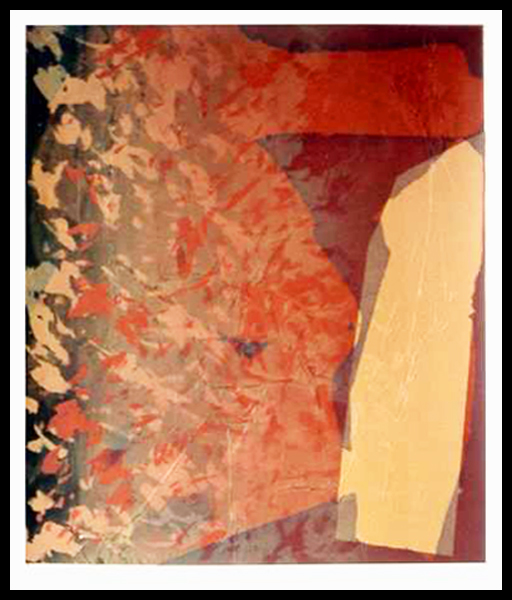
Untitled Screenprint 1983
For example, the above print incorporates two methods. The yellow ground was printed first, then later parts of this ground were masked out with paper before the red ink was squeezed through the screen. At a later stage, (on the left of the print) I drew directly onto the screen with screen-filler. Once it was dry I applied the blue ink.
Painting With Stencils
It was many years later that I began painting with stencils. This one, from 2006, shows evidence of 4 stencils.
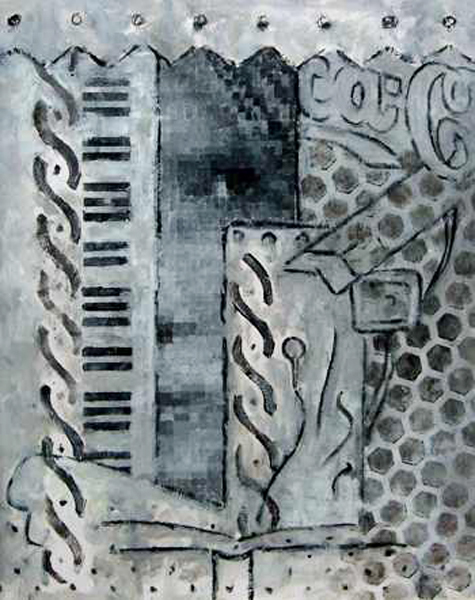
Watching You Watching Her #2, 2006, oil on paper, 62cm x 49cm
One stencil was used twice to make the helix motif. The keyboard stencil was used once, as was the well known brand of beverage stencil (top right).
At the same time, and wishing to adopt the tactic of make once, use many, I produced other works using some of the same stencils — as shown in the next painting. It also makes use of other stencils, which in turn did service in other paintings.
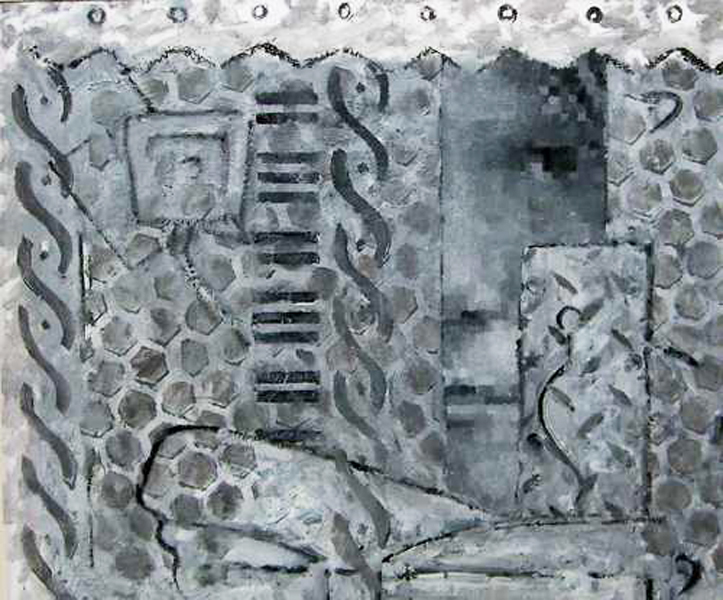
Watching You Watching Her #1, 2006, oil on paper, 47cm x 56cm
Speed, Scale and Durability
One of the great things about this technique is that I can quickly paint over a stencilled form and re-establish it elsewhere.
Changing the scale of my paintings means that I sometimes have to cut new stencils, and I do hand-cut them rather than rely on machined/found objects. There’s nothing wrong with using found objects, it’s simply that I prefer a handmade look. So in effect I draw with a Stanley knife (box cutter) or a pair of scissors.
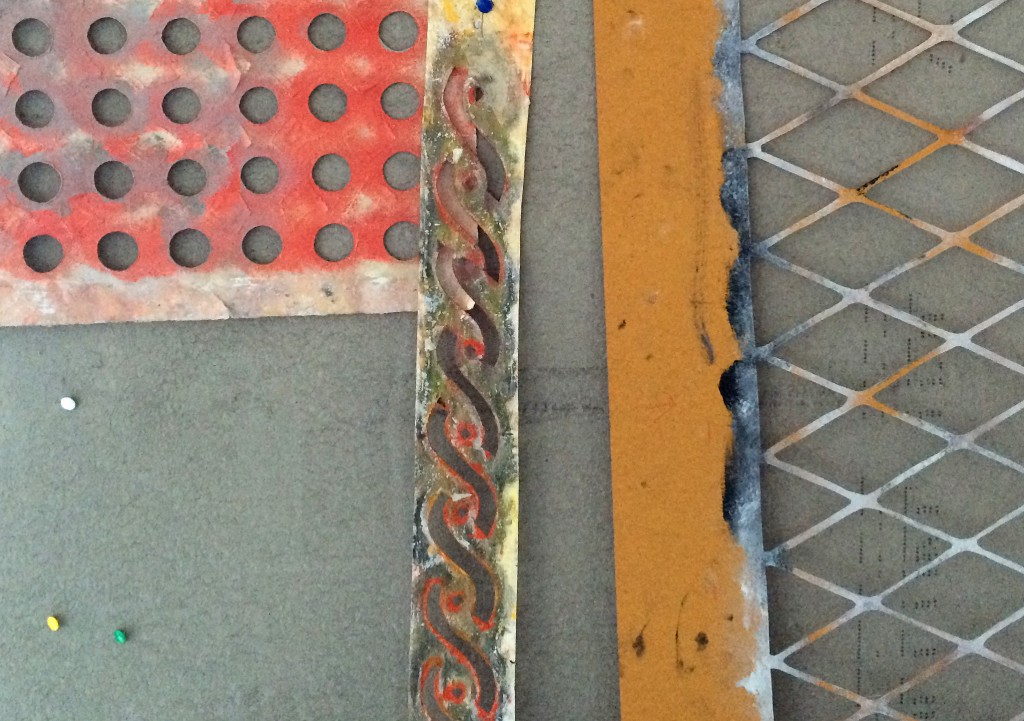
Left and right stencils cut from paper. The other is cut from stencil card.
For durability stencil card is better than paper. However, when I last tried to buy card I was told it was no longer manufactured. So now,I always use paper. I also change the blades regularly and use a ‘self healing’ cutting mat. Occasionally I have used MDF, which can be drilled, cut and/or routed in order to produce a durable stencil.
Further Developments in Reuse
Digital Images
Digital photography and the subsequent manipulation of images revolutionised my working methods. I am now able to easily produce a library of images which can be quickly plugged into any number of compositions, and like many artists I use Photoshop.
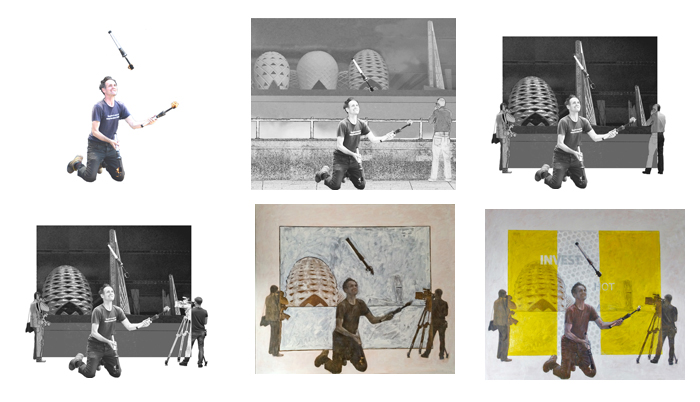
Top left. the original image of the juggler, then three variations of a digital image. Finally the painting, Showtime, in two stages.
Having created a series of related images, I choose one to paint, and having made that choice I see it through to the end, even though changes inevitably occur during the course of painting (as shown in the above composite image).
For further developments you may like to read my essay on using AI.
Piero della Francesca
The Legend of the True Cross
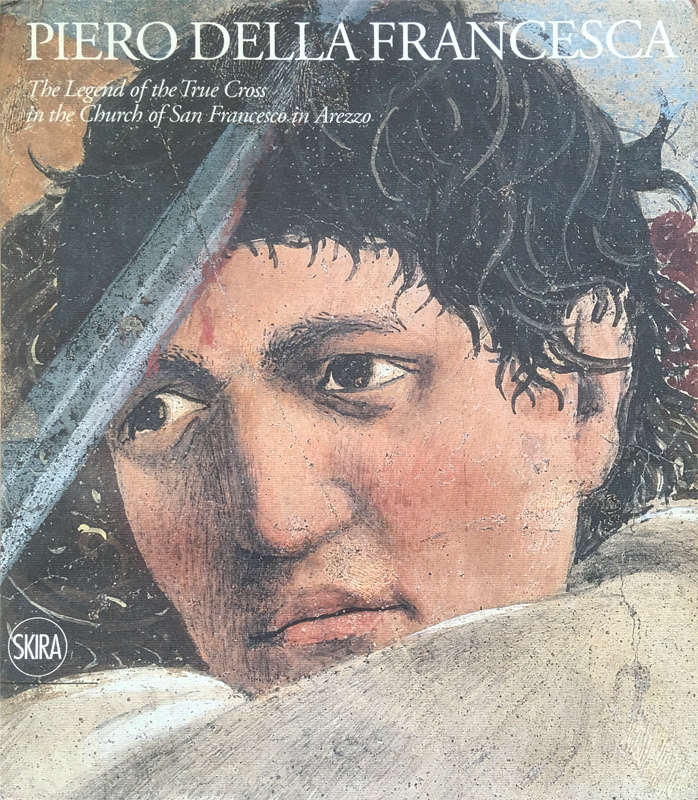
catalogue cover
In 2013, I visited Arezzo in Tuscany to see Piero della Fransca’s The Legend of the True Cross, a series of murals in the Basilica of San Francesco.
Seeing these up close, I noticed the residue of red chalk marks. These tiny points of chalk were a clear indication of the use of cartoons by the great Italian artist. Once these were made, and lines perforated with a custom made tool, his assistants placed these on wet plaster. Then by dusting chalk powder (pouncing) the design was visible once the cartoons were removed.
As a student, I studied Raphael’s cartoons in the Victoria and Albert Museum., and so I recognized the means Piero had used.
My use of stencils was simply another version of this method.
I also realised that by using Photoshop I could make any size of stencil I wanted.
The Photoshop Method
Once I have created a design, I make a full-size image in Photoshop. This matches the size of the support I intend to use.
Because I don’t have access to a large-format printer, I am forced to use A4. But that’s fine, albeit labour intensive. By carefully slicing the image, and therefore printing each slice full-size, I am left with any number of A4 sheets that need to be assembled. There are various ways of aligning everything, but I mostly go by eye.
Once I have made my cartoon, I am ready to take a knife to it. As I cut, I make decisions as to the nature of the forms. Sometimes I cut a line, other times I choose to isolate shapes. This is of course a process of abstracting the image, choosing to focus on what interests me.
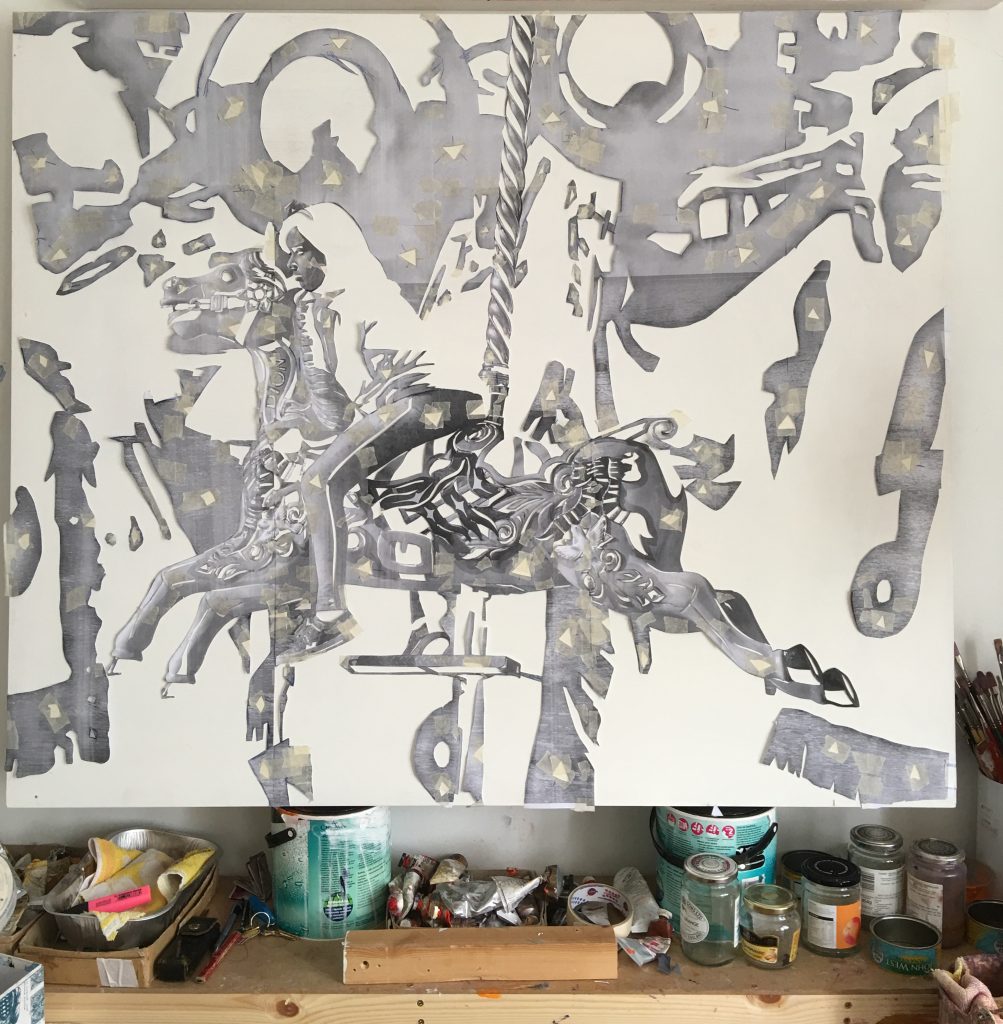
Paper stencil used for And the Band Played On
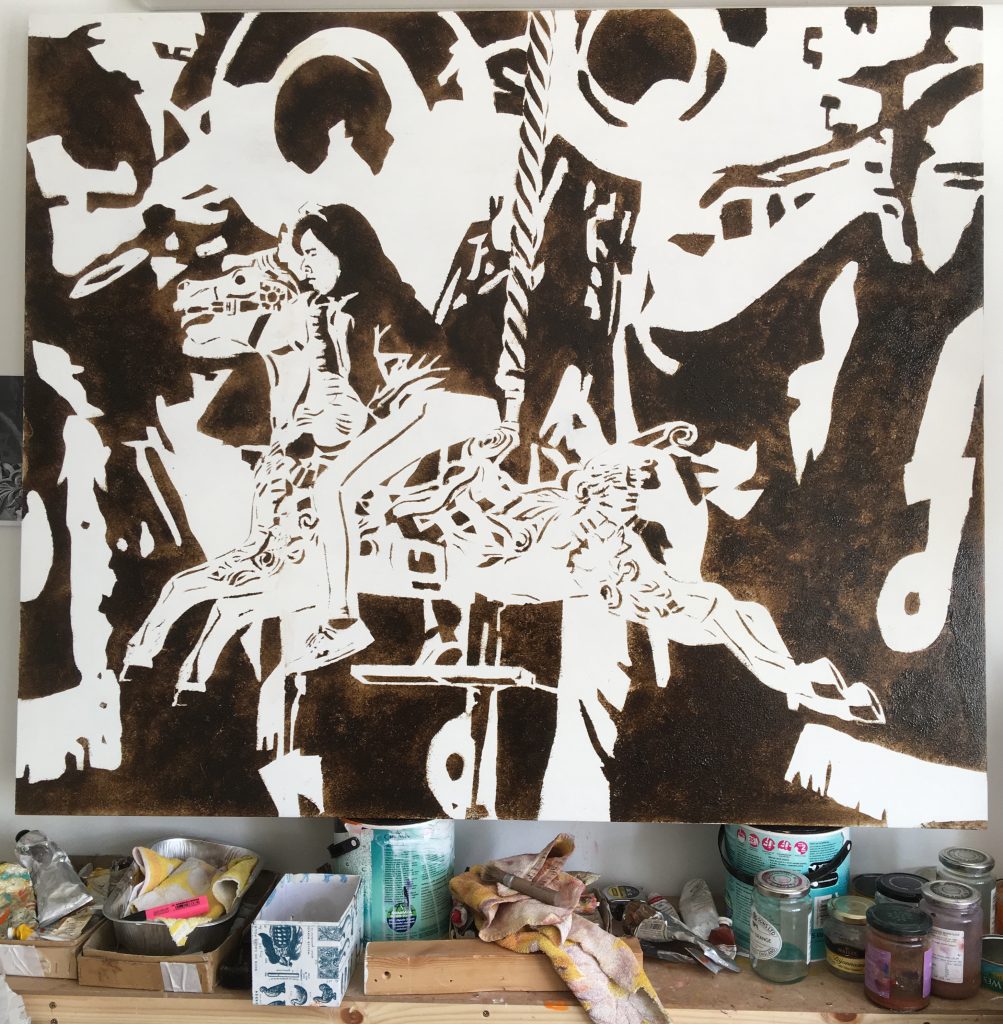
the design is established with oil paint
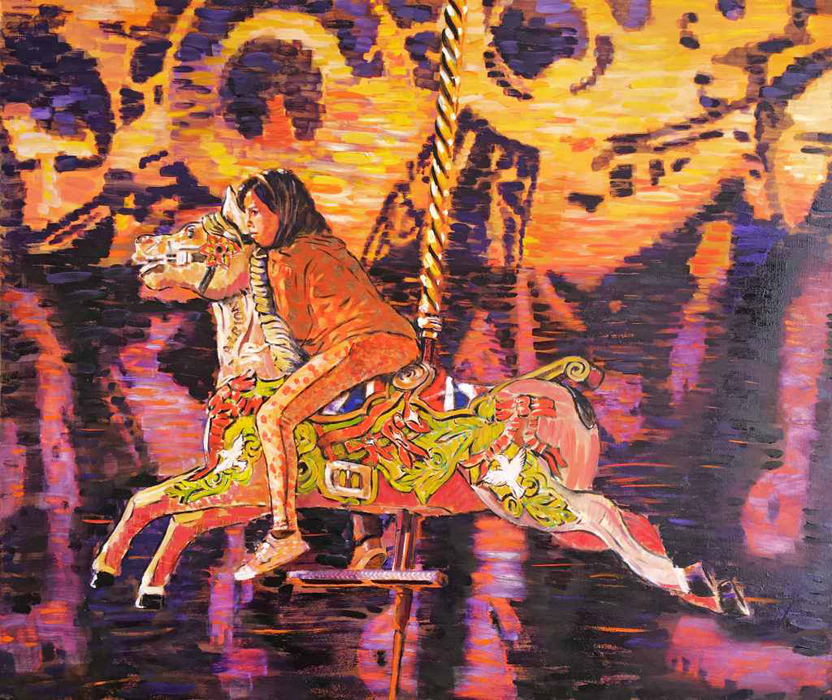
And the Band Played On, 103 cm x 122 cm, oil on MDF, 2017
Laziness is a Virtue
As a student, I got to know the painter Noel Forster. We didn’t see eye to eye on some matters, but I had a great respect for him as an artist.
He once said to me that looking for ways to make life easier for oneself is a virtue.
“If you want to draw that chair,” he said. “You can just project its shadow onto the canvas.”
That went against the grain of what many teachers thought about drawing and painting. Moreover I wasn’t too sure myself. But I respected Noel’s work enough to think he was probably onto something.
Many years later, I read an article by Larry Wall, the inventor of the Perl programming language. He claimed that laziness is one of three virtues a programmer should aspire to — the others being impatience and hubris. This of course chimed with Noel’s teaching, which in turn led me to see a possible way forward with my own work as a painter.
So I’m with Larry and Noel, and anyone else who wants to avoid breaking into a sweat, because I now see virtue where others see laziness.